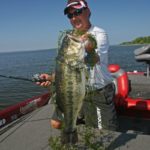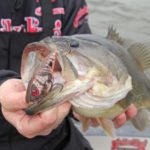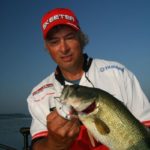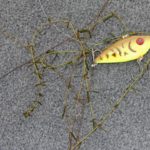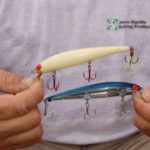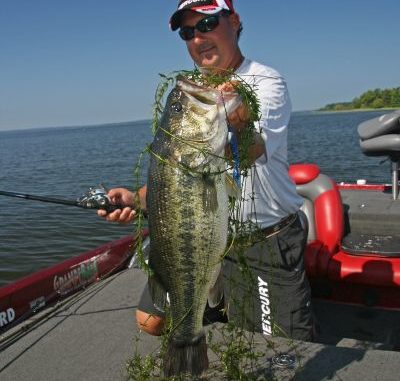
Intimidated by thick grass beds? That’s where big bass live, and drawing strikes requires some aggressive tactics
Folks often say that there’s a fine line between lunacy and brilliance, between foolishness and valor. Well, an equally thin margin separates the “Aw shucks!” and “Oh boy!” moments of bass fishing.
In at least one scenario — snagging grass — you can define that margin with the word “intent.”
No doubt, the practice of aiming a bait at clumps of hydrilla, milfoil, coontail or some gnarly mass of multiple aquatic plants might seem crazy at first blush. However, savvy bass anglers know that when hooks snag weeds, a forceful exit creates a sudden burst of activity that resembles forage darting from cover.
Maybe it’s a bluegill dashing out to grab a minnow or grass shrimp; perhaps it’s a crawfish relocating. In any case, ripping lipless crankbaits out of the grass is a downright deadly strategy.
It’s all about the reaction strike, and as Toledo Bend guide Stephen Johnston noted bass utilizing grass for cover often sit on the points and edges waiting for an easy meal to wander into reach.
Snag the right spot at the right time, and you can find yourself with quite the tussle on your hands.
The snag’s no drag
In general discussions, Trapping the grass lines seems to shine during spring’s prespawn and to some degree the post-spawn.
However, Buz Craft of Vidalia said anglers are wise to give this tactic a permanent spot in their game plan — even outside what may be considered prime time.
“Wherever you encounter grass, you can catch fish by ripping baits year-round,” Craft said. “It seems to be most effective in the late winter and early spring because people just seem to throw it more (during that period).”
That’s a mistake, he said.
“During the summertime, most people have more confidence in other baits, and they don’t really fish grass unless they’re dropping really deep or Carolina rigging in deep grass because they think that most of your bigger fish are positioned deep,” Craft explained. “But I think you can rip a Trap (during the summertime). It’s just that most people rely on other tactics when it gets hot.”
Craft said one of the less-talked-about yet consistently productive summertime alternatives involves shifting from a casting-and-ripping presentation to a more vertical deal: Just let that Trap fall down into deep grass in the 8- to 10-foot range, and then snatching it out.
There’s actually a presentation advantage here, Craft said, in that the vertical presentation allows for yo-yoing motion to thoroughly cover a promising area while keeping the bait close to the cover.
“That’s a technique that I’ve caught fish on during the summer,” Craft said. “Fish are curious; they’re going to look and see what’s in their house, and they get there and the bait rips out — it’s just a natural instinct that they’ll hit it.”
Now, those lipless crankbaits might get most of the attention, but don’t hesitate to run a squarebill or a medium diver down to a deeper grass edge.
EverStart tournament pro Phil Marks complements his crankbait ripping with a ½-ounce spinnerbait to give the fish a flashier look, while Craft points to a jerkbait as an often-overlooked ripping bait.
“When you have some water column over the top of the grass, that is a really good place to take a floating jerkbait and rip it down to the top edge of the grass,” Craft said. “A lot of times, those fish that are positioned under the grass will come up and get it.
“The jerkbait really shines when you have about 2 feet of water above the actual grass line. As long as you’re ticking the top of the grass, I call it ripping.”
When the Trap bite is good, Jeremy Guidry often uses a V&M Lightning Blade with a swimbait trailer like the V&M Kickin Shad or Lake Fork Live Magic Shad.
Guidry has no aversion to the lipless cranks — he rips with those, too. But over the years, he’s developed confidence in this alternative tactic.
“It’s just something a little different,” Guidry said. “The fish see so many Rat-L-Traps on places like Toledo Bend; I feel I go behind people (who are ripping the grass with Traps) and still get some bites that they missed.”
To get the most out of your grass-ripping presentations, consider a few tactical points:
• Color code — Baits for grass ripping follow the same basic color guidelines as any other scenario: brights like chartreuse for stained conditions, darker colors in low light conditions.
However, when fish are guarding fry in the grass, a bream pattern will bring out the beast of parental protection in a bass. Bream are notorious bass fry predators, so guarding adult bass will lay the smackdown on anything that resembles their hated adversary.
• Patience pays off — When ripping his Strike King Redeye Shad from grass edges, Marks said he’ll often take a subtle approach when the fish aren’t super aggressive.
A patient, controlled presentation, he said, is the key.
he trick is not to rip it immediately, but let the rod load up and then just pop it loose from the grass,” Marks said. “This allows the bait to stay in the strike zone longer, thus generating more strikes.”
• Keep the show going — Craft takes that the notion a step further with a teasing motion intended to attract attention from bass that might otherwise miss a simple in-and-out deal.
“Once you get your bait down into the deeper grass, give it a few little light shakes, in case there’s a fish trying to locate where it’s at — and then rip it,” he said. “A bass (in deep grass) might not notice the bait, unless you drop it right on his head. But they’re going to come check it out.
“It just helps to get them a little closer to the bait. Once you rip it out, kill it and let it fall. Give it seven or eight good, hard turns on the reel and kill it again. I promise you it will get their attention.”
